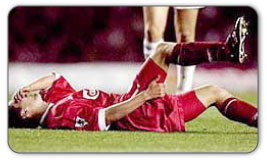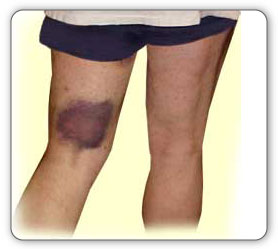Hamstring Contusion
A hamstring contusion is caused by a direct hit to the hamstring muscles at the back of the upper thigh and is very common during a collision in contact sports, such as football or rugby. A hard shot from a ball or hockey puck during play can also result in a contusion of the hamstring muscles. When the hit occurs, the muscle is crushed against the bone causing tissue damage that may result in swelling, bruising, pain, and limited movement in the upper leg.
Depending on the direction and force of the hit, and the strength of the hamstrings, the symptoms of a contusion can range from mild tenderness in the area to pain so severe you are not able to walk properly.
Intramuscular and Intermuscular Contusions
If the tissue damage, or tearing, occurs in the muscle and the fascia (muscular sheath) surrounding the muscle is not torn it is called an intramuscular contusion. The term intermuscular contusion is used when both the muscle and the fascia are torn.
If the contusion is intramuscular the bleeding is contained within the muscle sheath so visible bruising may not occur. However, pressure in the muscle increases from the bleeding which can cause pain and make movement difficult.
In the case of and intermuscular contusion, the blood escapes through the torn fascia and a bruise is usually visible. Healing time for an intermuscular contusion is generally faster than and intramuscular contusion because the blood and other fluid do not build up in the muscle which can cause swelling and blocked blood vessels.
For any hamstring contusion, the amount of time needed to heal can be reduced if cold compression is applied at the time of the hit and frequently during the following 72 hours.
Hamstring Contusion Symptoms
The symptoms of a hamstring contusion will differ depending on the severity of the impact. If you have suffered a hamstring contusion you will probably experience some degree of pain when walking uphill or up stairs, running, lunging, kicking, jumping, or bending forward. Other symptoms may include:
Grade 1 - Mild Contusion
- Tenderness in the area of the injury
- Slight swelling, if any
- Tightness in the calf muscles
- Possible difficulties walking but range of motion isn't affected much
Grade 2 - Moderate Contusion
- Limping
- Swelling
- Pain during activity and when pressure is applied at the injury site
- Limited movement
- Inability to stretch as far as usual
- Pain and stiffness with rest following activity, especially in the morning
Grade 3 - Severe Contusion
- Extreme pain at the time of injury with pain continuing for a few days
- Sudden and noticeable swelling
- Swelling and bruising that may extend down to the knee and calf
- Muscle spasm
- Weakness in the hamstring muscles
- Walking is impossible without assistance or crutches
- Difficulties sleeping due to pain
Treating a Hamstring Contusion
Hamstring pain is frustrating to live with and healing can take a long time because it's difficult to give your leg the rest it needs. This is especially true for runners and other athletes that return to their sport too early. However, resting your leg, and taking the pressure off by using crutches, is one of the best things you can do to allow healing. Jumping, running, kicking or lunging should be avoided to reduce stress on the posterior thigh muscles.
Treating a hamstring contusion with cold compression as soon as you can, and for the first 72 hours following injury, will help with recovery by reducing swelling and tissue damage. In the early stages of the injury, avoid stretching, massage, or heat treatments as it may lead to further bleeding in the area.
Product Advisors are available 9:00 am to 5:00 pm Eastern Standard Time Monday to Friday.
Learn More About Hamstring Injuries & TreatmentsI want to learn more about Hamstring Post-Surgery Recovery I want to learn more about the TShellz® Circulatory Boost Wrap I want to learn more about Ice & Heat: Which Is Better For Treatment? I want to learn more about Stretching for the Hamstring I want to learn more about Soft Tissue Injury Treatments
During your recovery, you will probably have to modify and/or eliminate any activities that cause pain or discomfort at the location of your soft tissue injury until the pain and inflammation settle. Always consult your doctor and/or Physical Therapist before using any of our outstanding products, to make sure they are right for you and your condition. The more diligent you are with your treatment and rehabilitation, the faster you will see successful results!
| 





